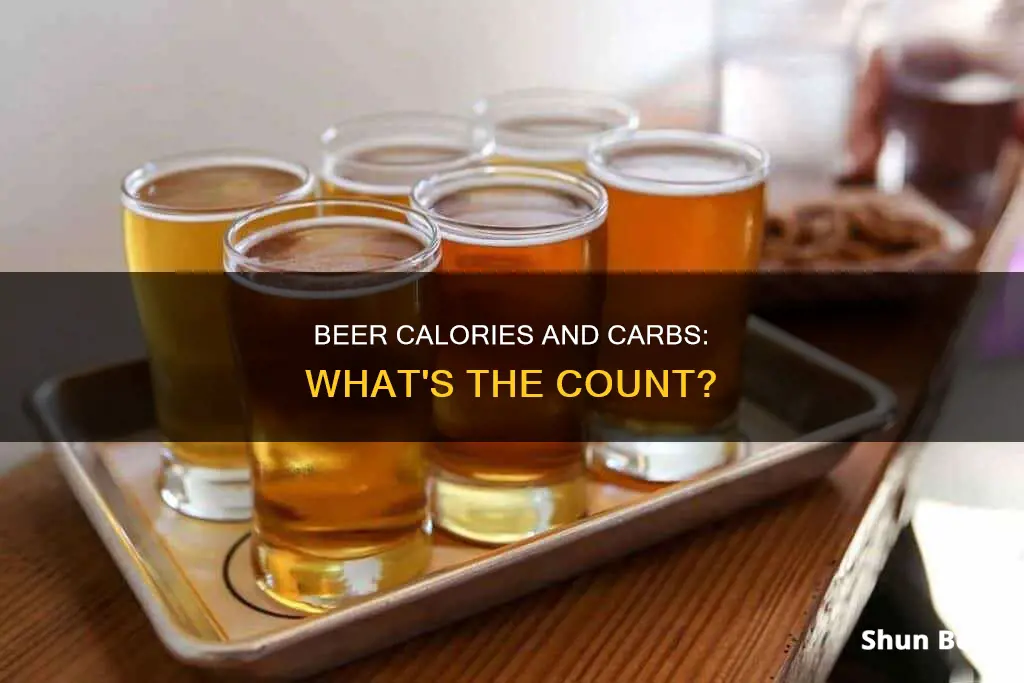
Beer is made from grains, which are healthy, but unfortunately, beer is not. Beer is a source of carbohydrates, and dark beers tend to have more carbs than light beers. A 12-ounce can of ale, lager, porter, premium beer, or stout has more than 12 grams of carbohydrates, while a light beer has about a quarter of that amount. Beer has no fat, and most of its calories come from carbohydrates. Beer also supplies minimal protein, with light beers containing about 0.7g and regular or dark beers containing about 1.6g.
Characteristics of Beer
| Characteristics | Values |
|---|---|
| Calories | 55-231 calories per 12-ounce serving |
| Carbohydrates | 1.9-32.1 grams per 12-ounce serving |
| Alcohol | 4.0-8.0% alcohol by volume |
| Protein | 0.6-1.9 grams per 12-ounce serving |
| Serving Size | 12 ounces (340g) is standard, but can vary |
What You'll Learn

Dark beers have more carbs than light beers
Beer is one of the most popular beverage choices, and its fans have strong opinions about whether dark or light beer tastes better. However, beer drinkers need to be aware of the nutritional differences between dark and light beers.
Dark Beers
Dark beers, like porters and stouts, are made from barley malt that has been darkly roasted. The darker the malt, the more intense the colour and the more sophisticated the taste. Dark beers usually have flavour notes of chocolate and toffee, produced by the roasting of the malt. They also tend to have a malty taste and added flavours such as coffee, chocolate, caramel, and nuts.
Dark beers have several health benefits. They contain tons of antioxidants that help prevent diseases like cataracts and, according to some studies, might also help prevent atherosclerosis, a disease that contributes to heart disease and stroke. Dark beers also have a high iron content, which can help you reach your daily value of iron, keeping your energy levels high and promoting healthy hair, skin and nails.
Light Beers
Light beers are characterised by a lighter colour and a lighter, hoppy flavour with citrus and floral notes. They have fewer calories and carbohydrates than dark beers, making them a popular choice for people watching their calorie intake or who are sensitive to the high carbohydrate content of darker beers.
Light beers don't have as many antioxidants or nutrients as dark beers, so they are not as effective at preventing cataracts or reducing the chance of blood clots. They also have a lower iron content.
Carbohydrates in Beer
Beer is made by fermenting grains such as barley and wheat, which contain carbohydrates. Most beers also contain added sugars, which further increase the carbohydrate level. The number of grains and added sugars that remain in the beer varies according to the fermentation process and the ingredients used.
Light beers generally have fewer carbohydrates than full-flavoured beers. Beers with very few carbs may be suitable for people on less restrictive low-carb diets.
Examples of Light and Dark Beers
Some examples of light beers include Bud Light, Busch Light, Coors Light, Miller Lite, and Michelob Ultra. Budweiser, Heineken, and Corona Extra are examples of darker beers.
Calorie Count in Busch Ice Beer: What You Need Know
You may want to see also

Light beers are lower in calories
Beer is made from grains, which can be healthy, but drinking beer is not necessarily good for you. Beer can be part of a healthy diet, but only when consumed in moderation. This means no more than two drinks per day or 14 drinks per week for men, and no more than one drink per day or seven drinks per week for women. Drinking more than this amount increases the risk of many health problems, including injuries and certain cancers.
Beer is made from fermented grains, such as barley and wheat, which contain carbohydrates. Most beers also contain added sugars, which increase the carbohydrate level in the beverage. The number of grains and added sugars that remain in the beer varies according to the fermentation process.
The exact number of calories and carbohydrates in beer depends on the brew and the amount consumed. Beer is typically high in calories, and these calories come mainly from carbohydrates and alcohol. Craft, seasonal, and high alcohol content beers tend to have more calories than lighter beers. If you are watching your calorie intake, opt for alcohol-free options, which usually contain fewer calories.
Dark beers tend to have more carbohydrates than light beers due to the way they are brewed with added malts. For example, a 12-ounce can of ale, lager, porter, premium beer, or stout has more than 12 grams of carbohydrates. That's about four times more carbs than a light beer.
Among the light beers, here's how they stack up in terms of calories and carbohydrates (per 12 oz.):
- Budweiser Select 55: 1.9 carbs, 55 calories
- MGD 64: 2.4 carbs, 64 calories
- Michelob Ultra: 2.6 carbs, 95 calories
- Natural Light: 3.2 carbs, 95 calories
- Busch Light: 3.2 carbs, 95 calories
- Miller Lite: 3.2 carbs, 96 calories
- Milwaukee's Best Light: 3.5 carbs, 98 calories
- Coors Light: 5.0 carbs, 102 calories
- Corona Light: 5.0 carbs, 109 calories
- Keystone Light: 5.1 carbs, 104 calories
- Amstel Light: 5.3 carbs, 95 calories
- Leinenkugel Light: 5.7 carbs, 105 calories
- Bud Light: 6.6 carbs, 95 calories
- Michelob Light: 6.7 carbs, 113 calories
- Heineken Light: 6.8 carbs, 99 calories
- MGD Light: 7.0 carbs, 110 calories
- Miller High Life Light: 7.0 carbs, 110 calories
- Leinenkugel Amber Light: 7.4 carbs, 110 calories
- Bud Ice Light: 7.5 carbs, 115 calories
- Bud Light Lime: 8.0 carbs, 116 calories
- Old Milwaukee Light: 8.3 carbs, 114 calories
- Sam Adams Light: 9.7 carbs, 124 calories
As you can see, light beers tend to have fewer calories and carbohydrates than their full-flavored counterparts. Beer may not be suitable for diets that severely restrict carbohydrates, but some light beers with very few carbs may be acceptable for less restrictive diets.
Calorie Count in Coronita Extra Beer: All You Need to Know
You may want to see also

Beer is made from grains
The number of calories in beer depends on the brew and the amount consumed. Beer is a source of carbohydrates, and dark beers tend to have more carbs than light beers due to the addition of malts during the brewing process. A 12-ounce can of ale, lager, porter, premium beer, or stout typically contains over 12 grams of carbohydrates, while a light beer has about a quarter of that amount.
Beer is also a source of calories, and craft, seasonal, and high-alcohol beers tend to have more calories than lighter beers. The calories in beer come mainly from carbs and alcohol. A 5% ABV beer has around 100 calories from alcohol alone, while a 4% ABV beer has about 80. The higher the ABV and the larger the pour size, the higher the calorie and carb count.
Beer also contains minimal protein, with light beers providing about 0.7 grams and regular or dark beers offering approximately 1.6 grams. Additionally, beer is made with some healthy ingredients like brewer's yeast, barley, malt, and hops, and it contains small amounts of folate, niacin, magnesium, and potassium. However, whole foods are better sources of these vitamins and minerals, and the calories from alcohol do not provide adequate nutrition for the body.
Calories in Beer: Understanding the Standard Beer's Energy Content
You may want to see also

Calories in beer come from carbs and alcohol
Beer is made from grains, which contain carbohydrates. Brewers use grains like barley and wheat to make beer, and these grains contribute to the carb content of the final product. Additionally, most beers also contain added sugars, which further increase the carbohydrate level.
The number of carbohydrates in beer can vary depending on several factors, such as the type of grains used, the fermentation process, and the overall sugar level. For example, dark beers tend to have more carbs than light beers due to the way they are brewed with added malts.
When it comes to calories, these also come primarily from the carbs and alcohol content in beer. Craft beers, seasonal beers, and beers with high alcohol content tend to have more calories than lighter beers. The higher the alcohol content, the higher the calorie count will be.
For instance, let's consider some of the most popular beers in the United States. Bud Light, a lighter beer, has 110 calories and 6.6 grams of carbs per 12-ounce serving. On the other hand, Budweiser, a heavier option, has 145 calories and 10.6 grams of carbs per 12-ounce serving.
If you're watching your calorie and carb intake, opting for light beers or alcohol-free options is a good strategy. These tend to have fewer calories and carbs while still allowing you to enjoy a beverage. However, it's important to remember that drinking in moderation is key. Excessive alcohol consumption can lead to various short-term and long-term health risks.
Calorie Count in Bud Light Apple Beer
You may want to see also

Alcohol-free beers have fewer calories
Beer is a popular drink made from fermented grains, such as barley and wheat, which contain carbohydrates. The number of carbohydrates in beer varies depending on the type of beer and the fermentation process. Generally, light beers have fewer calories and carbohydrates than full-flavored beers.
The calorie content of beer ranges from around 95 to just under 150 calories for a standard 12-ounce serving. For example, Budweiser Select 55 has 55 calories and 1.9 carbs, while a regular Budweiser has 145 calories and 10.6 grams of carbohydrates. Alcohol-free beers, such as Beck's NA non-alcoholic beer, have fewer calories, with only 57 calories and 11 grams of carbohydrates.
People watching their calorie and carbohydrate intake may want to opt for alcohol-free beers or light beers, such as Bud Light with 95 calories and 6.6 grams of carbohydrates. Additionally, drinking water between alcoholic beverages and sticking to a recommended limit of two drinks per day for men and one drink per day for women can help reduce calorie intake.
It is worth noting that beer has minimal protein content, with light beers providing about 0.7 grams and regular or dark beers offering around 1.6 grams. Beer also has no fat, and most of its calories come from carbohydrates. While beer is not considered a health drink, it can be consumed in moderation as part of a healthy diet.
Presidente Beer: Calorie Count and Health Considerations
You may want to see also
Frequently asked questions
The number of carbs and calories in beer depends on the type of beer and the serving size. A standard 12-ounce serving of popular beers in the United States ranges from around 95 calories on the low end to just under 150 calories on the high end. Light beers tend to have fewer carbs and calories than full-flavored beers.
Budweiser Select 55 has 1.9 carbs and 55 calories per 12 oz serving, making it one of the lowest-calorie and lowest-carb beers available. Other low-calorie options include Beck's Premier Light, with 64 calories and 3.9 grams of carbohydrates per serving, and Michelob Ultra, with 95 calories and 2.6 grams of carbohydrates per serving.
In general, yes. Dark beers tend to have more carbs than light beers due to the way they are brewed with added malts. For example, a 12-ounce can of ale, lager, porter, premium beer, or stout typically has more than 12 grams of carbohydrates, which is about four times more carbs than a light beer.
Here are some strategies to reduce your calorie intake when drinking beer:
- Opt for light beers or alcohol-free options, which tend to have fewer calories.
- Drink a glass of water between each alcoholic beverage.
- Use a pre-measured cup to keep track of your portion sizes.
- Add fruit to your beer for a kick of nutrients.







